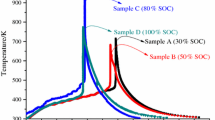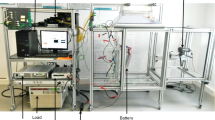Abstract
Since lithium-ion battery with high energy density is the key component for next-generation electrical vehicles, a full understanding of its thermal behaviors at different discharge rates is quite important for the design and thermal management of lithium-ion batteries (LIBs) pack/module. In this work, a 25 Ah pouch type Li[Ni0.7Co0.15Mn0.15]O2/graphite LIBs with specific energy of 200 Wh·kg−1 were designed to investigate their thermal behaviors, including temperature distribution, heat generation rate, heat capacity and heat transfer coefficient with environment. Results show that the temperature increment of the charged pouch batteries strongly depends on the discharge rate and depth of discharge. The heat generation rate is mainly influenced by the irreversible heat effect, while the reversible heat is important at all discharge rates and contributes much to the middle evolution of the temperature during discharge, especially at low rate. Subsequently, a prediction model with lumped parameters was used to estimate the temperature evolution at different discharge rates of LIBs. The predicted results match well with the experimental results at all discharge rates. Therefore, the thermal model is suitable to predict the average temperature for the large-scale batteries under normal operating conditions.











Similar content being viewed by others
References
Sun YK, Myung ST, Park BC, Park BC, Prakash J, Belharouak I, Amine K. High-energy cathode material for long-life and safe lithium batteries. Nat Mater. 2009;8(4):320.
Noh HJ, Youn S, Yoon CS, Sun YK. Comparison of the structural and electrochemical properties of layered Li[Ni x Co y Mn z ]O2. J Power Sources. 2013;233(1):121.
Hamut H, Dincer I, Naterer G. Performance assessment of thermal management systems for electric and hybrid electric vehicles. Int J Energy Res. 2013;37(1):1.
Hong JS, Maleki H, Al Hallaj S, Ready L, Selman JR. Electrochemical-calorimetric studies of lithium-ion cells. J Electrochem Soc. 1998;145(5):1489.
Spotnitz RM, Weaver J, Yeduvaka G, Doughty DH, Roth EP. Simulation of abuse tolerance of lithium-ion battery packs. J Power Sources. 2007;163(2):1080.
Troxler Y, Wu B, Marinescu M, Yufit V, Patel Y, Marquis AJ, Brandon NP, Offer GJ. The effect of thermal gradients on the performance of lithium-ion batteries. J Power Sources. 2014;247(2):1018.
Awarke A, Jaeger M, Oezdemir O, Pischinger S. Thermal analysis of a Li-ion battery module under realistic EV operating conditions. Int J Energy Res. 2013;37(6):617.
Smith K, Kim GH, Darcy E, Pesaran A. Thermal/electrical modeling for abuse-tolerant design of lithium ion modules. Int J Energy Res. 2010;34(2):204.
Al Hallaj S, Maleki H, Hong J, Selman JR. Thermal modeling and design considerations of lithium-ion batteries. J Power Sources. 1999;83(1):1.
Kobayashi Y, Kihira N, Takei K, Miyashiro H, Kumai K, Terada N, Ishikawa R. Electrochemical and calorimetric approach to spinel lithium manganese oxide. J Power Sources. 1999;81(9):463.
Santhanagopalan S, Zhang Q, Kumaresan K, White RE. Parameter estimation and life modeling of lithium-ion cells. J Electrochem Soc. 2008;155(4):A345.
Li WC, Lu SG. Thermal behavior of C/LiFePO4 power secondary battery. Trans Nonferrous Met Soc China. 2012;22(4):1156.
Forgez C, Do DV, Friedrich G, Morcrette M, Delacourt C. Thermal modeling of a cylindrical LiFePO4/graphite lithium-ion battery. J Power Sources. 2010;195(9):2961.
Waag W, Käbitz S, Sauer DU. Experimental investigation of the lithium-ion battery impedance characteristic at various conditions and aging states and its influence on the application. Appl Energy. 2013;102(2):885.
Bernardi D, Pawlikowski E, Newman J. A general energy balance for battery systems. J Electrochem Soc. 1985;132(1):5.
Doyle M, Fuller TF, Newman J. Modeling of galvanostatic charge and discharge of the lithium/polymer/insertion cell. J Electrochem Soc. 1993;140(6):1526.
Chen Y, Evans JW. Heat transfer phenomena in lithium/polymer-electrolyte batteries for electric vehicle application. J Electrochem Soc. 1993;140(7):1833.
Pals CR, Newman J. Thermal modeling of the lithium/polymer battery II. Temperature profiles in a cell stack. J Electrochem Soc. 1995;142(10):3282.
Song L, Evans JW. Electrochemical-thermal model of lithium polymer batteries. J Electrochem Soc. 2000;147(6):2086.
Inui Y, Kobayashi Y, Watanabe Y, Watase Y, Kitamura Y. Simulation of temperature distribution in cylindrical and prismatic lithium ion secondary batteries. Energy Convers Manag. 2007;48(7):2103.
Jeon DH, Baek SM. Thermal modeling of cylindrical lithium ion battery during discharge cycle. Energy Convers Manag. 2011;52(8):2973.
Abdul-Quadir Y, Laurila T, Karppinen J, Jalkanen K, Vuorilhto K, Skogström L, Paulasto-Kröckel M. Heat generation in high power prismatic Li-ion battery cell with LiMnNiCoO2 cathode material. Int J Energy Res. 2014;38(11):1424.
Bandhauer TM, Garimella S, Fuller TF. A critical review of thermal issues in lithium-ion batteries. J Electrochem Soc. 2011;158(3):R1.
Kang J, Rizzoni G. Study of relationship between temperature and thermal energy, operating conditions as well as environmental factors in large-scale lithium-ion batteries. Int J Energy Res. 2014;38(15):1994.
Srinivasan V, Wang CY. Analysis of electrochemical and thermal behavior of Li-ion cells. J Electrochem Soc. 2003;150(1):A98.
Maleki H, Al Hallaj S, Selman JR, Dinwiddie RB, Wang H. Thermal properties of lithium-ion battery and components. J Electrochem Soc. 1999;146(3):947.
Chen SC, Wang YY, Wan CC. Thermal analysis of spirally wound lithium batteries. J Electrochem Soc. 2006;153(4):A637.
Yi J, Kim US, Shin CB, Han T, Park S. Three-dimensional thermal modeling of a lithium-ion battery considering the combined effects of the electrical and thermal contact resistances between current collecting tab and lead wire. J Electrochem Soc. 2013;160(3):A437.
Spotnitz R, Franklin J. Abuse behavior of high-power, lithium-ion cells. J Power Sources. 2003;113(1):81.
Chen Y, Evans JW. Thermal analysis of lithium-ion batteries. J Electrochem Soc. 1996;143(9):2708.
Chen S, Wan C, Wang Y. Thermal analysis of lithium-ion batteries. J Power Sources. 2005;140(1):111.
Bang H, Yang H, Sun YK, Prakash J. In situ studies of Li x Mn2O4 and Li x Al0.17Mn1.83O3.97S0.03 cathode by IMC. J Electrochem Soc. 2005;152(2):A421.
Kim JS, Prakash J, Selman J. Thermal characteristics of Li x Mn2O4 spinel. Electrochem Solid-State Lett. 2001;4(9):A141.
Williford RE, Viswanathan VV, Zhang JG. Effects of entropy changes in anodes and cathodes on the thermal behavior of lithium ion batteries. J Power Sources. 2009;189(1):101.
Kim US, Shin CB, Kim CS. Effect of electrode configuration on the thermal behavior of a lithium-polymer battery. J Power Sources. 2008;180(2):909.
Onda K, Kameyama H, Hanamoto T, Ito K. Experimental study on heat generation behavior of small lithium-ion secondary batteries. J Electrochem Soc. 2003;150(3):A285.
Thomas KE, Newman J. Heats of mixing and of entropy in porous insertion electrodes. J Power Sources. 2003;119(6):844.
Kim US, Shin CB, Kim CS. Modeling for the scale-up of a lithium-ion polymer battery. J Power Sources. 2009;189(1):841.
Rao L, Newman J. Heat-generation rate and general energy balance for insertion battery systems. J Electrochem Soc. 1997;144(8):2697.
Yeow K, Teng H, Thelliez M, Tan E. Comparative study on thermal behavior of lithium-ion battery systems with indirect air cooling and indirect liquid cooling. In: Proceedings of the ASME/ISCIE International Symposium on Flexible Automation. Missouri, USA: St. Louis; 2012. 585.
Zhang X. Thermal analysis of a cylindrical lithium-ion battery. Electrochim Acta. 2011;56(3):1246.
Al Hallaj S, Prakash J, Selman J. Characterization of commercial Li-ion batteries using electrochemical–calorimetric measurements. J. Power Sources. 2000;87(1):186.
Doyle M, Newman J, Gozdz AS, Schmutz CN, Tarascon JM. Comparison of modeling predictions with experimental data from plastic lithium ion cells. J Electrochem Soc. 1996;143(6):1890.
Srinivasan V, Wang C. Analysis of electrochemical and thermal behavior of Li-ion cells. J Electrochem Soc. 2003;150(1):A98.
Verbrugge MW. Three-dimensional temperature and current distribution in a battery module. J AIChE. 1995;41(6):1550.
Al Hallaj S, Venkatachalapathy R, Prakash J, Selman JR. Entropy changes due to structural transformation in the graphite anode and phase change of the LiCoO2 cathode. J Electrochem Soc. 2000;147(7):2432.
Viswanathan VV, Choi D, Wang D, Xu W, Towne S, Williford RE, Zhang JG, Liu J, Yang ZG. Effect of entropy change of lithium intercalation in cathodes and anodes on Li-ion battery thermal management. J Power Sources. 2010;195(11):3720.
Thomas KE, Newman J. Thermal modeling of porous insertion electrodes. J Electrochem Soc. 2003;150(2):A176.
Ohshima T, Nakayama M, Fukuda K, Araki T, Onda K. Thermal behavior of small lithium-ion battery during rapid charge and discharge cycles. J Power Sources. 2006;157(3):17.
Kumaresan K, Sikha G, White RE. Thermal model for a Li-ion cell. J Electrochem Soc. 2008;155(2):A164.
Acknowledgments
This research was financially supported by the Program from Ministry of Science and Technology of China (No. 2011AA11A254) and the National High Technology Research and Development Program of China (No. 2012AA110102).
Author information
Authors and Affiliations
Corresponding author
Rights and permissions
About this article
Cite this article
Yun, FL., Tang, L., Li, WC. et al. Thermal behavior analysis of a pouch type Li[Ni0.7Co0.15Mn0.15]O2-based lithium-ion battery. Rare Met. 35, 309–319 (2016). https://doi.org/10.1007/s12598-015-0605-3
Received:
Revised:
Accepted:
Published:
Issue Date:
DOI: https://doi.org/10.1007/s12598-015-0605-3




